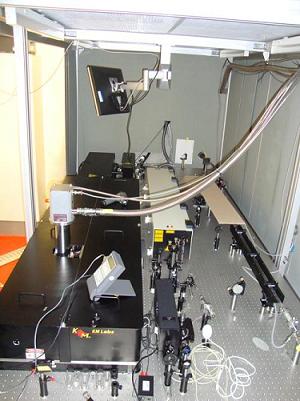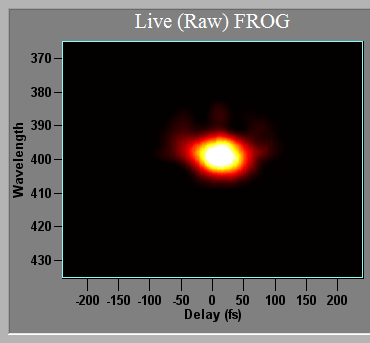Laser Physics
|
History Since 1999 we entered the field of intense laser-atom physics with an experiment (at the university of Marburg) where we examined the well known knee structure of the intensity dependent double ionization rate in helium and argon. For the first time, we could prove that the origin of the knee structure, the so called nonsequential contribution to the double ionization, is in fact due to the correlated emission of two electrons as being suggested years ago. We are still working on correlated electrons and ions originating from atoms, clusters and molecules after strong field laser excitation. The particles are measured / detected in our COLTRIMS setups, which enable simultaneous detection of more than 1 electron and ion. The Laser Laboratory Since 2004, we have our own Ti:Sapphire amplified laser system in our laboratory from KM Labs. The laser is a commercial multi-pass amplifier system, called Dragon, capable of delivering up to 0.75 mJ of 30 fs pulses at a repetition rate of 10 kHz. The seed pulses originate from a sub 15 fs oscillator at 790 nm and at 80 MHz repetion rate. The multi-pass amplifier is pumped by a commercial high-power high-repetition rate ns laser from Lee Laser. The amplifier crystal is cryogenically cooled to allow for high-intensity laser pulses at high repetition rate. Currently, the laser system performs reliably. A photo of the laser table is shown in the figure 1. On the left side, the amplifier laser system (KM Labs) is shown.  In the left top corner the oscillator is located, which is pumped by a continuous high power laser (Verdi from Coherent). The big black box (center left) is the Dragon amplifier, with the Cryostat sticking out of the box. Next to the Dragon in the white box is the pump laser (from Lee laser). Pulse characterisation n the center at the bottom of the photo, a small black box is shown, which is our commercial Grenouille from Swamp Optics. This is a commercial device for femtosecond laser pulse charaterisation. The raw FROG trace of the amplified laser pulse is shown in figure 2, showing an almost transform limited laser pulse of 35 fs (25 nm FWHM bandwidth).  Another characterization we are employing is the interferometric autocorrelation on rare gases in the COLTRIMS machine. Results will be shown soon.... Ultrashort (sub 15 fs) laser pulses On the right side of the laser table in the photo of the laser table, a hollow fiber with a core of 250 micron is located. The hollow fiber is a proven technique to be able to shorten the laser pulses with reasonable (25-50%) efficiency. The self-phase modulation causes the spectrum of the laser pulse to broaden and subsequently the pulses can be compressed by use of dielectric chirped mirrors. We intend to generate short, sub 15 fs laser pulses and perform pump-probe experiments. Figure 3 shows how the fiber looks like under experiment conditions. The top left photo is the way the fiber looks in the lab with the exit on the right side. The spectrum of the original amplifier pulse and the broadenend laser pulse are shown in the graph. The spectrum can be much broader than shown, only this would not allow to record a FROG trace with the commercial Grenouille. The FROG trace for a moderately broadened laser pulse is also shown, which clearly shows a temporally shortened laser pulse and the pulse is properly compressed by the chirped mirrors.  Other Another experimental possiblity is frequency conversion by use of nonlinear crystals (frequency doubling or conversion to the visible). |